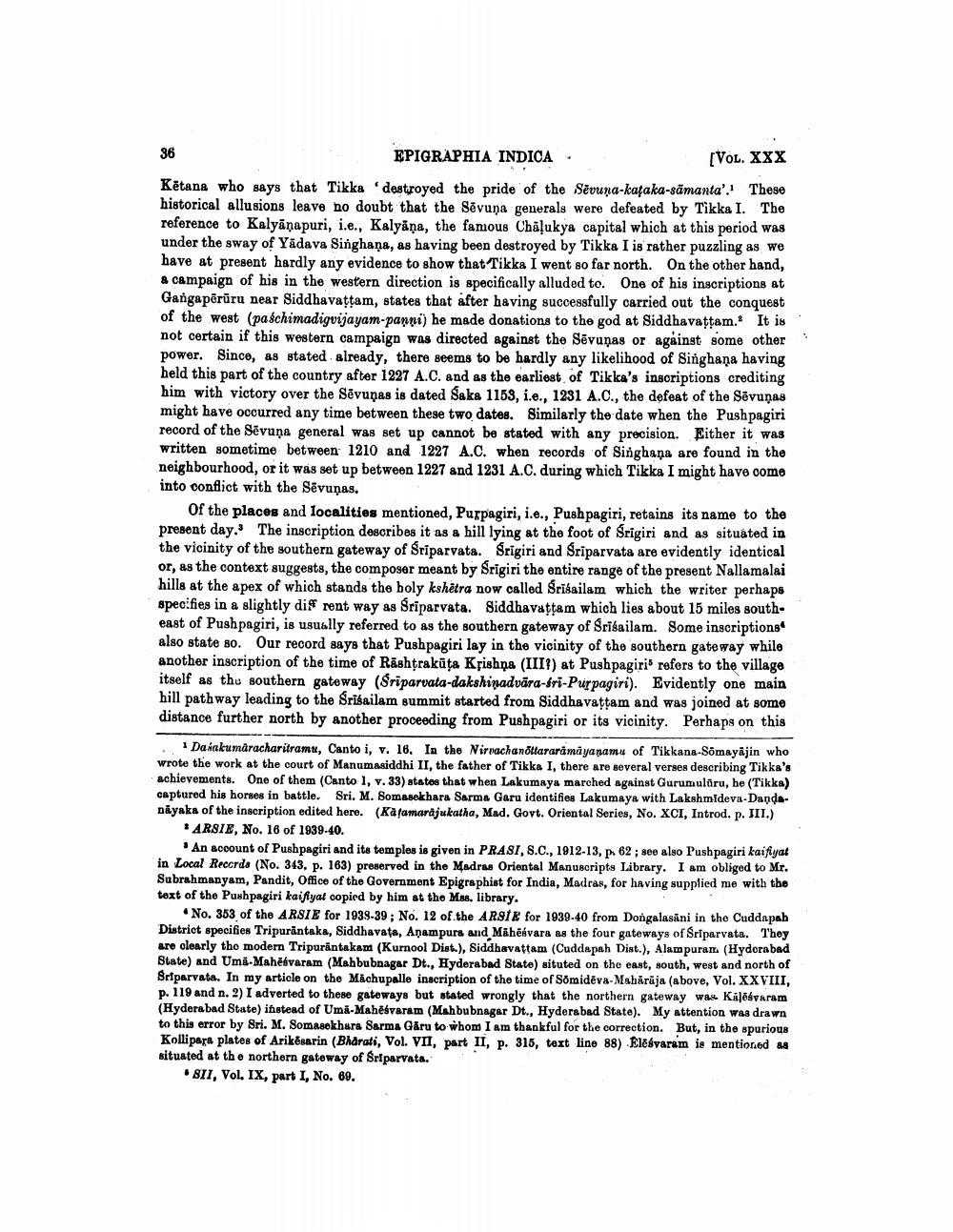________________
EPIGRAPHIA INDICA.
[VOL. XXX
Kētana who says that Tikka destroyed the pride of the Sèvuna-kataka-sämanta'.' These historical allusions leave no doubt that the Sēvuna generals were defeated by Tikka I. The reference to Kalyanapuri, i.e., Kalyana, the famous Chalukya capital which at this period was under the sway of Yadava Singhaņa, as having been destroyed by Tikka I is rather puzzling as we have at present hardly any evidence to show that Tikka I went so far north. On the other hand, a campaign of his in the western direction is specifically alluded to. One of his inscriptions at Gangapērūru near Siddhavattam, states that after having successfully carried out the conquest of the west (paschimadigvijayam-panni) he made donations to the god at Siddhavattam. It is not certain if this western campaign was directed against the Sēvunas or against some other power. Since, as stated already, there seems to be hardly any likelihood of Singhana having held this part of the country after 1227 A.C. and as the earliest of Tikka's inscriptions crediting him with victory over the Sovunas is dated Saka 1153, i.e., 1231 A.O., the defeat of the Sēvunas might have occurred any time between these two dates. Similarly the date when the Pushpagiri record of the Sēvuna general was set up cannot be stated with any precision. Either it was written sometime between 1210 and 1227 A.C. when records of Singhaņa are found in the neighbourhood, or it was set up between 1227 and 1231 A.C. during which Tikka I might have come into oonflict with the Sēvuņas.
Of the places and localities mentioned, Purpagiri, i.e., Push pagiri, retains its name to the present day. The inscription describes it as a hill lying at the foot of Srigiri and as situated in the vicinity of the southern gateway of Sriparvata. Srigiri and Sriparvata are evidently identical or, as the context suggests, the composer meant by Srigiri the entire range of the present Nallamalai hills at the apex of which stands the boly kshetra now called Srisailam which the writer perhaps specifies in a slightly dif rent way as Sriparvata. Siddhavattam which lies about 15 miles southeast of Pushpagiri, is usually referred to as the southern gateway of Srisailam. Some inscriptions also state so. Our record says that Pushpagiri lay in the vicinity of the southern gateway while another inscription of the time of Rāshțrakūta Krishna (III?) at Pushpagiri' refers to the village itself as the southern gateway (Sriparvata-dakshinadvāra-bri-Purpagiri). Evidently one main hill pathway leading to the Srisailam summit started from Siddhavattam and was joined at some distance further north by another proceeding from Pushpagiri or its vicinity. Perhaps on this
Daiakumaracharitrama, Canto i, v. 18. In the Nirvachanollararamayanamu of Tikkana-Somayajin who wrote the work at the court of Manumasiddhi II, the father of Tikka I, there are several verses describing Tikka's achievements. One of them (Canto 1, v. 33) states that when Lakumaya marched against Gurumuläru, be (Tikka) captured his horses in battle. Sri. M. Somssekhara Sarma Garu identifies Lakumaya with Lakshmideva-Dandaniyaka of the inscription edited here. (Kajamarájukatha, Mad. Govt. Oriental Series, No. XCI, Introd. p. JIT.)
* ARSIE, No. 18 of 1939-40.
. An account of Pushpagiri and its temples is given in PRASI, S.C., 1912-13, p. 62 ; see also Pushpagiri kaifiyat in Local Records (No. 343. p. 163) preserved in the Madras Oriental Manuscripts Library. I am obliged to Mr. Subrahmanyam, Pandit, Office of the Government Epigraphist for India, Madras, for having supplied me with the toxt of the Pushpagiri kaisyal copied by him at the Mas, library.
• No. 353 of the ARSIE for 1938-39 : No. 12 of the ARSIB for 1939-40 from Dongalasani in the Cuddapah District specifies Tripurantaka, Siddhavata, Anampurs and Mahēbvara as the four gateways of Sriparvata. They are clearly the modern Tripurantakam (Kurnool Dist.), Siddhavattam (Cuddapah Dist.), Alampuram (Hydorabad State) and Umi-Mahesvaram (Mahbubnagar Dt., Hyderabad State) situted on the east, south, west and north of Sriparvata. In my article on the Machupalle inscription of the time of Somidēva-Mahārāja (above, Vol. XXVIII, p. 119 and n. 2) I adverted to these gateways but stated wrongly that the northern gateway was Kilēsvaram (Hyderabad State) instead of Umä-Mahēsvaram (Mahbubnagar Dt., Hyderabad State). My attention was drawn to this error by Sri. M. Somasekhara Sarma Gåru to whom I am thankful for the correction. But, in the spurious Kollipara plates of Arikbaarin (Bharati, Vol. VII, part II, p. 315, text line 88) Elodvaram is mentioned as situated at the northern gateway of Sriparvata.
.811, Vol. IX, part I, No. 69.




